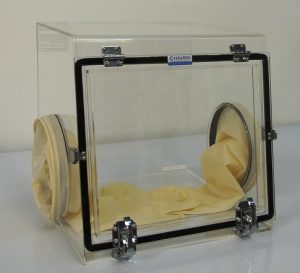A laboratory glove box is a sealed workstation designed to manipulate potentially hazardous chemicals and materials safely. The box is fitted with gloves on all its openings so that no outside air can enter it. This way, the only air inside is at the same pressure as outside or negative pressure, which prevents dangerous chemicals from escaping into open spaces.
Laboratory Glove Box technology is widely used in pharmaceutical and biological laboratories to protect researchers from exposure to pathogens and chemicals. As well as being used by drug and chemical manufacturers, they are also widely used in universities government laboratories such as the Food and Drug Administration’s Center for Veterinary Medicine.
Modern Types of Glove Boxes
Glove boxes are made of either metal or plastic and have covers that protect the interior from ultraviolet light, allowing them to protect from the environment. They are usually manufactured in sizes made to fit into specific spaces. Many also come equipped with filters and misting systems to keep the air inside clean and safe. There are various types of laboratory glove boxes, depending on their applications.
1. Inert Gas Glovebox

Inert Gas glove boxes contain a high concentration of inert gas such as sulfur hexafluoride, which is non-toxic and does not react with other chemicals. It provides a low humid and low oxygen environment for oxygen-sensitive materials. It has a relatively high boiling point and uses in many industrial applications for fire protection.
2. Modified Atmosphere Glove Box
Modified atmosphere glove boxes are designed to allow researchers to manipulate chemicals that are subject to oxidation or corrosion when exposed to oxygen. They are typically filled with nitrogen, preventing oxygen’s oxidizing or corrosive effects from harming work inside. Carbon Dioxide filled glove boxes are also an option, but they require more care when working in them because of the higher toxicity level of CO2 exposure.
3. Vacuum Glove Box

Vacuum glove boxes are specifically designed to conserve the use of oxygen in the area where they are used and allow the worker to work inside them with no risk of exposure to air. A vacuum could be created by placing a chamber inside a less-oxygen-filled machine or lab space, filling it with an inert gas such as nitrogen, or using an air pump.
4. Glove bags
A glove bag is a smaller, open-ended glove box used for work that does not require a glove box’s complete protection. They are made of plastic or nylon and have a drawstring closure. They are often used in biological labs and clean rooms to manipulate biological materials. They can also be used for the assembly of microelectronic devices.
Some critical Applications of Glove Box

As you have seen, glove boxes have many properties that make them ideal lab equipment for many scientific applications. Some of its essential applications are discussed below.
- Drug Manufacturing: Glove boxes are used during the commercial production, testing, and storage of drugs. Gloves on columns and piping, along with an air pumping system, are used to prevent the escape of any potentially dangerous chemicals. In addition to working in glove boxes, some workers also wear protective clothing as a precautionary measure.
- DNA/Molecule Manipulation: Glove box isolators have been specifically designed to enhance the manipulation of DNA sequencing samples while keeping contamination levels at bay. Thus preventing germs and other contaminants from harming samples or research results.
- Gaseous Exposures: Many laboratories use glove boxes to control gaseous exposures in their work areas. These types of gloves are especially beneficial in the area of asbestos abatement poisoning, where fibers can cause severe lung diseases such as asbestosis, silicosis, and mesothelioma cancer.
- Patient Safety: Glove boxes are used to reduce the risks of accidental exposures to potentially harmful substances in hospitals and clinics, where there is a greater risk of infection from bacteria or viruses. Glove bag workspaces have been designed for these facilities to promote patient safety further, bearing certain similarities to those found in clean rooms.
Many experienced and novices can use Laboratory Glove Box to protect themselves from harmful fumes and airborne contaminants during the research and development of new medicines, chemicals, and vaccines. However, it should be noted that glove boxes cannot prevent exposures from other sources such as scratches, cuts, and penetrating injuries.


